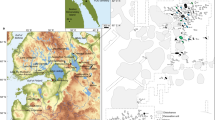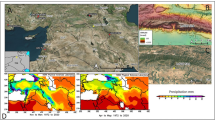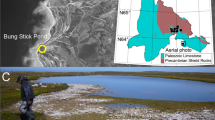Abstract
The Sahara west of the Nile in southern Egypt was hyperarid and unoccupied during most of the Late Pleistocene epoch. About 11,000 years ago1 the summer monsoons of central Africa moved into Egypt, and temporary lakes or playas were formed. The Nabta Playa depression, which is one of the largest in southern Egypt, is a kidney-shaped basin of roughly 10 km by 7 km in area2,3,4. We report the discovery of megalithic alignments and stone circles next to locations of Middle and Late Neolithic communities at Nabta, which suggest the early development of a complex society. The southward shift of the monsoons in the Late Neolithic age rendered the area once again hyperarid and uninhabitable some 4,800 radiocarbon years before the present (years bp). This well-determined date establishes that the ceremonial complex of Nabta, which has alignments to cardinal and solstitial directions, was a very early megalithic expression of ideology and astronomy. Five megalithic alignments within the playa deposits radiate outwards from megalithic structures, which may have been funerary structures. The organization of the megaliths suggests a symbolic geometry that integrated death, water, and the Sun. An exodus from the Nubian Desert at ∼4,800 years bp may have stimulated social differentiation and cultural complexity in predynastic Upper Egypt.
This is a preview of subscription content, access via your institution
Access options
Subscribe to this journal
Receive 51 print issues and online access
$199.00 per year
only $3.90 per issue
Buy this article
- Purchase on Springer Link
- Instant access to full article PDF
Prices may be subject to local taxes which are calculated during checkout



Similar content being viewed by others
References
Wendorf, F. et al. in Egypt During the Last Interglacial (eds, Wendorf, F., Close, A. E. & Schild, R.) 552–573 (Plenum, New York, (1993)).
Wendorf, F., Close, A. E. & Schild, R. Megaliths in the Egyptian Sahara. Sahara 5, 7–16 (1992–1993).
Wendorf, F. & Schild, R. Prehistory of the Eastern Sahara (Academic, New York, (1990)).
Close, A. E. (ed.) Prehistory of Arid North Africa (Southern Methodist Univ. Press, Dallas, (1987)).
Gautier, A. in Prehistory of Arid North Africa (ed. Close, A. E.) 163–187 (Southern Methodist Univ. Press, Dallas, (1987)).
Close, A. E. & Wendorf, F. in Transitions to Agriculture in Prehistory (eds Gebauer, A. B. & Price, T. D.) 63–72 (Prehistory, Madison, (1992)).
Wendorf, F., Schild, R. & Close, A. Cattle Keepers of the Eastern Sahara (Publications in Anthropology, Southern Methodist Univ., Dallas, (1984)).
Wendorf, F. & Schild, R. Nabta Playa during the Early and Middle Holocene. ANKH 4/5, 33–45 (1995–1996).
Banks, K. M. in Prehistory of the Eastern Sahara (eds Wendorf, F. & Schild, R.) 300–315 (Academic, New York, (1990)).
Aveni, A. F. Tropical archaeoastronomy. Science 243, 161–171 (1981).
Burl, A. From Carnac to Callanish: The Prehistoric Stone Rows and Avenues of Britain, Ireland, and Brittany (Yale Univ. Press, New Haven, (1993)).
Acknowledgements
This paper is based upon research carried out by the Combined Prehistoric Expedition, which is jointly sponsored by the Southern Methodist University, the Institute of Archaeology and Ethnology, the Polish Academy of Sciences, and the Geological Survey of Egypt. Fieldwork was partly supported by the grants from the US National Science Foundation. We thank the Egyptian Antiquities Organization and A. Radwan for support and assistance.
Author information
Authors and Affiliations
Corresponding author
Rights and permissions
About this article
Cite this article
Malville, J., Wendorf, F., Mazar, A. et al. Megaliths and Neolithic astronomy in southern Egypt. Nature 392, 488–491 (1998). https://doi.org/10.1038/33131
Received:
Accepted:
Issue Date:
DOI: https://doi.org/10.1038/33131
This article is cited by
-
Climatic reconstruction at the Sannai-Maruyama site between Bond events 4 and 3—implication for the collapse of the society at 4.2 ka event
Progress in Earth and Planetary Science (2019)
Comments
By submitting a comment you agree to abide by our Terms and Community Guidelines. If you find something abusive or that does not comply with our terms or guidelines please flag it as inappropriate.



